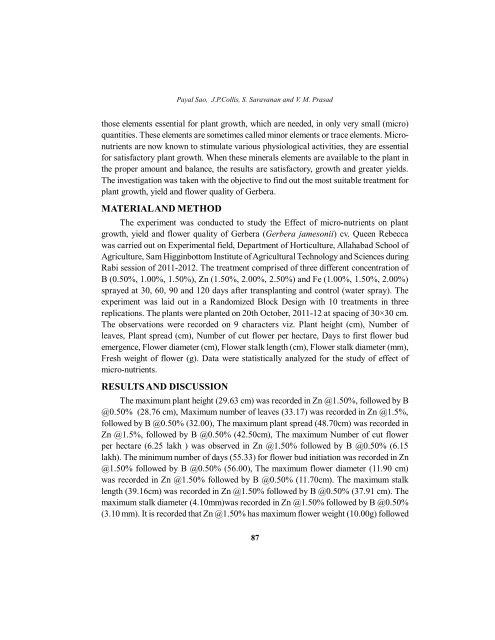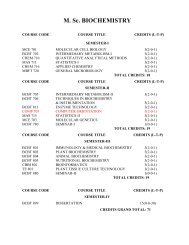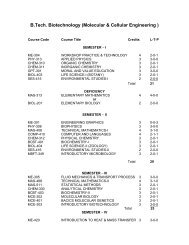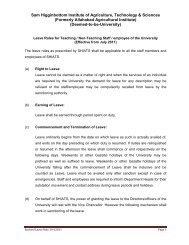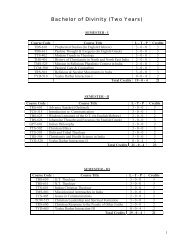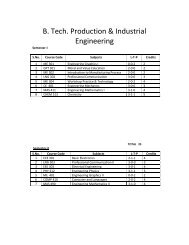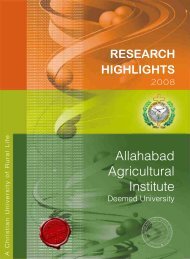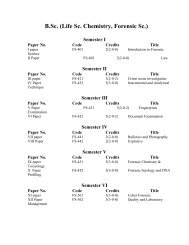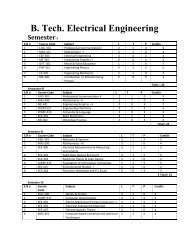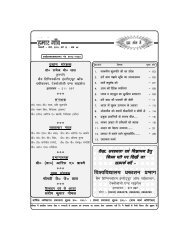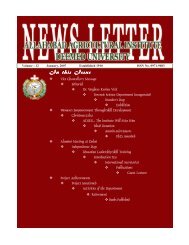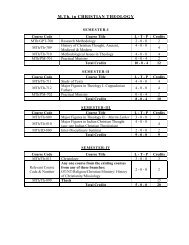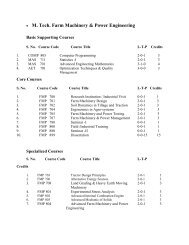The Allahabad Farmer Vol. LXVIII, January - 2013 No. 2Effect <strong>of</strong> Micro-Nutrients on Plant Growth, Yield and FlowerQuality <strong>of</strong> Gerbera (Gerbera jamesonii L.)cv. Queen RebeccaPayal Sao * , J.P.Collis , S. Saravanan and V. M. Prasad •ABSTRACTThe present experiment was conducted at Research Farm, Department <strong>of</strong>Horticulture, Allahabad School <strong>of</strong> Agriculture, Sam Higg<strong>in</strong>bottom Institute <strong>of</strong>Agriculture Technology & Sciences (Deemed to be university), Allahabad, dur<strong>in</strong>gthe year 2011-2012. The experiment was laid out <strong>in</strong> a Randomized Block Designhav<strong>in</strong>g n<strong>in</strong>e treatments with three replications. The treatment comprised <strong>of</strong> threedifferent concentration <strong>of</strong> three micro-nutrients B (0.50%, 1.00%, 1.50%), Zn(1.50%, 2.00%, 2.50%), Fe (1.00%, 1.50%, 2.00%) and sprayed at 30, 60, 90 and120 days after plant<strong>in</strong>g and control (water spray). The result revealed that Zn1.50% was found most effective for obta<strong>in</strong><strong>in</strong>g maximum plant height (29.93),Maximum number <strong>of</strong> leaves per plant (33.17), maximum plant spread (48.70cm.),m<strong>in</strong>imum number <strong>of</strong> days (55.33) for first flower bud emergence, maximum flowerdiameter (11.90cm), maximum stalk length (39.16cm), maximum stalk diameter(4.10mm), maximum number <strong>of</strong> cut flower (10.00), flowers per plot (40.00) andflower yield per hectare (62.50 lakh) and fresh weight <strong>of</strong> flower (10.00g).Key word- Gerbera, Zn, B, Fe, Gerbera jamesonii L. cv. Queen RebeccaINTRODUCTIONGerbera is one <strong>of</strong> the most important cut flowers, successfully grown under differentconditions <strong>in</strong> several areas <strong>of</strong> the world. It belongs to family Asteraceae and is commonlyknown as Transvaal, African or Barbeton Daisy. It is native <strong>of</strong> Tropical Asia and Africa.Gerbera produces attractive flowers known as 'head' or capitulum. The plants are stemlessperennial herbs. It is the fifth most used cut flower <strong>in</strong> the world (after rose, carnation,chrysanthemum, and tulip). The Gerbera blooms almost year round. Micro-nutrients are*M.Sc. Student, Assistant Pr<strong>of</strong>essor, Associate Pr<strong>of</strong>essor, • Pr<strong>of</strong>essor & HeadDepartment <strong>of</strong> Horticulture, SHIATS, Allahabad – 211007 (U.P.)86
Payal Sao, J.P.Collis, S. Saravanan and V. M. Prasadthose elements essential for plant growth, which are needed, <strong>in</strong> only very small (micro)quantities. These elements are sometimes called m<strong>in</strong>or elements or trace elements. Micronutrientsare now known to stimulate various physiological activities, they are essentialfor satisfactory plant growth. When these m<strong>in</strong>erals elements are available to the plant <strong>in</strong>the proper amount and balance, the results are satisfactory, growth and greater yields.The <strong>in</strong>vestigation was taken with the objective to f<strong>in</strong>d out the most suitable treatment forplant growth, yield and flower quality <strong>of</strong> Gerbera.MATERIAL AND METHODThe experiment was conducted to study the Effect <strong>of</strong> micro-nutrients on plantgrowth, yield and flower quality <strong>of</strong> Gerbera (Gerbera jamesonii) cv. Queen Rebeccawas carried out on Experimental field, Department <strong>of</strong> Horticulture, Allahabad School <strong>of</strong>Agriculture, Sam Higg<strong>in</strong>bottom Institute <strong>of</strong> Agricultural Technology and Sciences dur<strong>in</strong>gRabi session <strong>of</strong> 2011-2012. The treatment comprised <strong>of</strong> three different concentration <strong>of</strong>B (0.50%, 1.00%, 1.50%), Zn (1.50%, 2.00%, 2.50%) and Fe (1.00%, 1.50%, 2.00%)sprayed at 30, 60, 90 and 120 days after transplant<strong>in</strong>g and control (water spray). Theexperiment was laid out <strong>in</strong> a Randomized Block Design with 10 treatments <strong>in</strong> threereplications. The plants were planted on 20th October, 2011-12 at spac<strong>in</strong>g <strong>of</strong> 30×30 cm.The observations were recorded on 9 characters viz. Plant height (cm), Number <strong>of</strong>leaves, Plant spread (cm), Number <strong>of</strong> cut flower per hectare, Days to first flower budemergence, Flower diameter (cm), Flower stalk length (cm), Flower stalk diameter (mm),Fresh weight <strong>of</strong> flower (g). Data were statistically analyzed for the study <strong>of</strong> effect <strong>of</strong>micro-nutrients.RESULTS AND DISCUSSIONThe maximum plant height (29.63 cm) was recorded <strong>in</strong> Zn @1.50%, followed by B@0.50% (28.76 cm), Maximum number <strong>of</strong> leaves (33.17) was recorded <strong>in</strong> Zn @1.5%,followed by B @0.50% (32.00), The maximum plant spread (48.70cm) was recorded <strong>in</strong>Zn @1.5%, followed by B @0.50% (42.50cm), The maximum Number <strong>of</strong> cut flowerper hectare (6.25 lakh ) was observed <strong>in</strong> Zn @1.50% followed by B @0.50% (6.15lakh). The m<strong>in</strong>imum number <strong>of</strong> days (55.33) for flower bud <strong>in</strong>itiation was recorded <strong>in</strong> Zn@1.50% followed by B @0.50% (56.00), The maximum flower diameter (11.90 cm)was recorded <strong>in</strong> Zn @1.50% followed by B @0.50% (11.70cm). The maximum stalklength (39.16cm) was recorded <strong>in</strong> Zn @1.50% followed by B @0.50% (37.91 cm). Themaximum stalk diameter (4.10mm)was recorded <strong>in</strong> Zn @1.50% followed by B @0.50%(3.10 mm). It is recorded that Zn @1.50% has maximum flower weight (10.00g) followed87
- Page 1 and 2:
The Allahabad Farmer Vol. LXVIII, J
- Page 3 and 4:
The Allahabad Farmer Vol. LXVIII, J
- Page 5 and 6:
The Allahabad Farmer Vol. LXVIII, J
- Page 7 and 8:
The Allahabad Farmer Vol. LXVIII, J
- Page 9 and 10:
The Allahabad Farmer Vol. LXVIII, J
- Page 11 and 12:
The Allahabad Farmer Vol. LXVIII, J
- Page 13 and 14:
The Allahabad Farmer Vol. LXVIII, J
- Page 15 and 16:
The Allahabad Farmer Vol. LXVIII, J
- Page 17 and 18:
The Allahabad Farmer Vol. LXVIII, J
- Page 19 and 20:
The Allahabad Farmer Vol. LXVIII, J
- Page 21 and 22:
The Allahabad Farmer Vol. LXVIII, J
- Page 23 and 24:
The Allahabad Farmer Vol. LXVIII, J
- Page 25 and 26:
The Allahabad Farmer Vol. LXVIII, J
- Page 27 and 28:
The Allahabad Farmer Vol. LXVIII, J
- Page 29 and 30:
The Allahabad Farmer Vol. LXVIII, J
- Page 31 and 32:
Verma Rekha and Parvez RaziaINTRODU
- Page 33 and 34:
Verma Rekha and Parvez RaziaThe ves
- Page 35 and 36: Verma Rekha and Parvez RaziaThe poo
- Page 37 and 38: The Allahabad Farmer Vol. LXVIII, J
- Page 39 and 40: The Allahabad Farmer Vol. LXVIII, J
- Page 41 and 42: The Allahabad Farmer Vol. LXVIII, J
- Page 43 and 44: The Allahabad Farmer Vol. LXVIII, J
- Page 45 and 46: The Allahabad Farmer Vol. LXVIII, J
- Page 47 and 48: The Allahabad Farmer Vol. LXVIII, J
- Page 49 and 50: The Allahabad Farmer Vol. LXVIII, J
- Page 51 and 52: The Allahabad Farmer Vol. LXVIII, J
- Page 53 and 54: The Allahabad Farmer Vol. LXVIII, J
- Page 55 and 56: The Allahabad Farmer Vol. LXVIII, J
- Page 57 and 58: The Allahabad Farmer Vol. LXVIII, J
- Page 59 and 60: The Allahabad Farmer Vol. LXVIII, J
- Page 61 and 62: The Allahabad Farmer Vol. LXVIII, J
- Page 63 and 64: The Allahabad Farmer Vol. LXVIII, J
- Page 65 and 66: The Allahabad Farmer Vol. LXVIII, J
- Page 67 and 68: The Allahabad Farmer Vol. LXVIII, J
- Page 69 and 70: The Allahabad Farmer Vol. LXVIII, J
- Page 71 and 72: The Allahabad Farmer Vol. LXVIII, J
- Page 73 and 74: The Allahabad Farmer Vol. LXVIII, J
- Page 75 and 76: The Allahabad Farmer Vol. LXVIII, J
- Page 77 and 78: The Allahabad Farmer Vol. LXVIII, J
- Page 79 and 80: The Allahabad Farmer Vol. LXVIII, J
- Page 81 and 82: Neetesh Gupta, S. Saravanan and V.
- Page 83 and 84: Neetesh Gupta, S. Saravanan and V.
- Page 85: Neetesh Gupta, S. Saravanan and V.
- Page 89 and 90: Payal Sao, J.P.Collis, S. Saravanan
- Page 91 and 92: Aarti Shrivas, Suryendra Singh, San
- Page 93 and 94: Aarti Shrivas, Suryendra Singh, San
- Page 95 and 96: Aarti Shrivas, Suryendra Singh, San
- Page 97 and 98: Pradeep Kumar, S.S. Sengarinvolves
- Page 99 and 100: Pradeep Kumar, S.S. SengarREFERENCE
- Page 101 and 102: Avantika Pandey, Natasha Nageswaran
- Page 103 and 104: Avantika Pandey, Natasha Nageswaran
- Page 105 and 106: Avantika Pandey, Natasha Nageswaran
- Page 107 and 108: Aradhana Irene Charan, Nishant Kuma
- Page 109 and 110: Aradhana Irene Charan, Nishant Kuma
- Page 111 and 112: Aradhana Irene Charan, Nishant Kuma
- Page 113 and 114: The Allahabad Farmer Vol. LXVIII, J
- Page 115 and 116: The Allahabad Farmer Vol. LXVIII, J
- Page 117 and 118: Apala Gupta, Prema Devi and V.P. Sa
- Page 119 and 120: Apala Gupta, Prema Devi and V.P. Sa
- Page 121 and 122: Apala Gupta, Prema Devi and V.P. Sa
- Page 123 and 124: Apala Gupta, Prema Devi and V.P. Sa
- Page 125 and 126: Sudarshan Subedi, Neena Gupta, Vari
- Page 127 and 128: Sudarshan Subedi, Neena Gupta, Vari
- Page 129 and 130: Sudarshan Subedi, Neena Gupta, Vari
- Page 131 and 132: Sudarshan Subedi, Neena Gupta, Vari
- Page 133: Sudarshan Subedi, Neena Gupta, Vari


